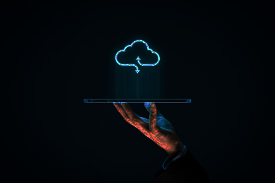IoT Cloud Solutions

Difference between Cloud, Fog and Edge Computing in IoT
We’ve heard a lot about cloud computing as the most prominent form of IoT data management. Along with cloud computing, fog and edge computing are becoming popular as well. Let’s compare these three forms of data technologies, examine their differences and benefits.
Cloud Computing in IoT Environment
Cloud computing is the standard of IoT data storage right now. It’s the form of computing where data is stored on multiple servers and can be accessed online from any device. Instead of saving information to the local hard drive on a single computer, users store it on third-party online servers.
To access data, a user needs to enter an account associated with the cloud service. The data undergoes end-to-end encryption, so even service providers have no access to the user’s contents. For the Internet of Things, this means securely storing and managing a lot of data and having immediate access to it from multiple devices, anytime, anywhere.
Difference between Fog and Edge Computing
These computing technologies differ by their design and purpose but often complement each other. Let’s take a look at edge computing vs fog computing and analyze their purposes and differences.
▪ Fog Computing

The term fog computing was coined by Cisco, and it defines a mix of a traditional centralized data storage system and a Cloud. Computing is performed at local networks, although servers themselves are decentralized. The data, therefore, can be accessed offline because some portions of it are stored locally as well. This is the key distinction between fog computing vs cloud computing, where all the intelligence and computing are performed on remote servers.
▪ Edge Computing
Edge computing processes data away from centralized storage, keeping information on the local parts of the network — edge devices. When the data is sent to the edge device, it can be processed directly on it, without being sent to the centralized cloud.
How do fog and edge computing work?
Fog computing is useful when the Internet connection isn’t always stable. For instance, on connecting trains, the fog system can pull up locally stored data on areas where the Internet connection can’t be maintained.
How is data processed by fog computing?
- Urgent requests are sent directly to the fog and processed locally in the network;
- Less sensitive data is transferred to the cloud’s main data centers where it’s stored and analyzed;
- Under normal conditions, the majority of data goes to the cloud, local storage is used in scenarios where saving bandwidth is a priority.
Fog computing allows implementing data processing at the local networks, especially if it has to be processed in real-time. This is what makes this storage form incredibly stable under stressful conditions, especially when comparing cloud vs fog computing.
Edge computing is the least vulnerable form of decentralized storage. On the cloud, data is distributed to dozens of servers, whereas edge computing uses hundreds, possibly thousands of local nodes. Each device can act as a server in the edge network. To break into, hackers would need access to thousands of distributed devices, which is practically impossible.

Advantages of fog computing and edge computing
Edge and fog computing is less known than cloud but has a lot to offer to businesses and IoT companies in particular. These networks solve many issues that can’t be solved by IoT cloud computing services and adapt the decentralized data storage to particular needs. Let’s examine their benefits individually before comparing these systems side by side.
Benefits of fog computing
- Low latency; the fog network can process large volumes of data with little-to-no delay. Because a lot of data is stored locally, the computing is performed faster.
- Better data control; in cloud computing, third-party servers are fully disconnected from local networks, leaving little to no control over data. In fog computing, users can manage a lot of information locally and rely on their security measures.
- A flexible storage system; Fog computing doesn’t require constant online access. The data can be stored locally or pulled up from local drives — such storage combines online and offline access.
- Connecting centralized and decentralized storage; Fog computing builds a bridge between local drives and third-party cloud services, allowing a smooth transition to fully decentralized data storage.
Many companies focus on edge computing on their way to decentralization, whereas others adopt fog computing as a main data storage system due to its high speed and increased availability.
Benefits of edge computing
o No delays in the data processing. The data stays on the “edges” of the IoT network and can be acted on immediately.
o Real-time data analysis. Works great when large amounts of data have to be processed and immediately.
o Low network traffic. The data is first processed locally, and only then sent to the main storage.
o Reduced operating costs. Data management takes less time and computing power because the operation has a single destination, instead of circling from the center to local drives.
o IoT edge computing is an optimal solution for small immediate operations that have to be processed with millisecond rates.
When many small operations are happening simultaneously, performing them locally is faster and cheaper.
1. Access control
2. IP PBX TELEPHONY SOLUTION (VoIP-EPABX)
3. Firewall and Network Security Solutions
4. IoT Solutions for Advanced business models
5. AI & Robotic Solutions
6. E-commerce, Logistics, and distribution integrated Platform building services
7. Edu-Tech Solutions (Advanced LMS platforms for Smart Class rooms using IoT)
